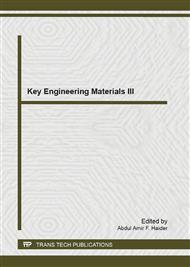p.188
p.192
p.197
p.202
p.207
p.212
p.217
p.225
p.229
Thermal Stability Study of Ce0.75-Zr0.25O Nanostructures Synthesized via Water-in-Oil Microemulsion Method
Abstract:
Fundamentally, ceria particle had ability to store, transport and release oxygen, which was identified as oxygen storage capacity (OSC). Due to this OSC ability, ceria became the most important component in the three-way catalyst. With the addition of zirconia into the ceria resulting in better performance in three-way catalyst as it increased or improved thermal stability and also promotes the redox properties. This study was conducted to investigate the effects of heat treatment on the structure and physical property of nanocrystalline Ce-Zr-O solid solution. Microemulsion method was used for preparation of Ce-Zr-O solid solution, and heat treatment investigation was applied towards the synthesized nanocrystalline Ce-Zr-O solid solution. The phase and crystal structure of Ce-Zr-O solid solution were determined using XRD analysis. While, the modification of surface area and porosity size over the wide range of calcination temperatures range from 300°C to 700°C was investigated using BET Analyzer. XRD analysis confirmed the Ce0.75Zr0.25O2 solid solution was succesfully synthesized in the research. The results exhibited the effect of heat treatment on the decreasing of surface areas and porosity profiles of the Ce0.75Zr0.25O2. Despite of the reduction of surface areas at elevated temperatures, the study found the promising results that the enhancement of thermal stability of ceria by addition of zirconia.
Info:
Periodical:
Pages:
207-211
Citation:
Online since:
May 2013
Authors:
Keywords:
Price:
Сopyright:
© 2013 Trans Tech Publications Ltd. All Rights Reserved
Share:
Citation:


